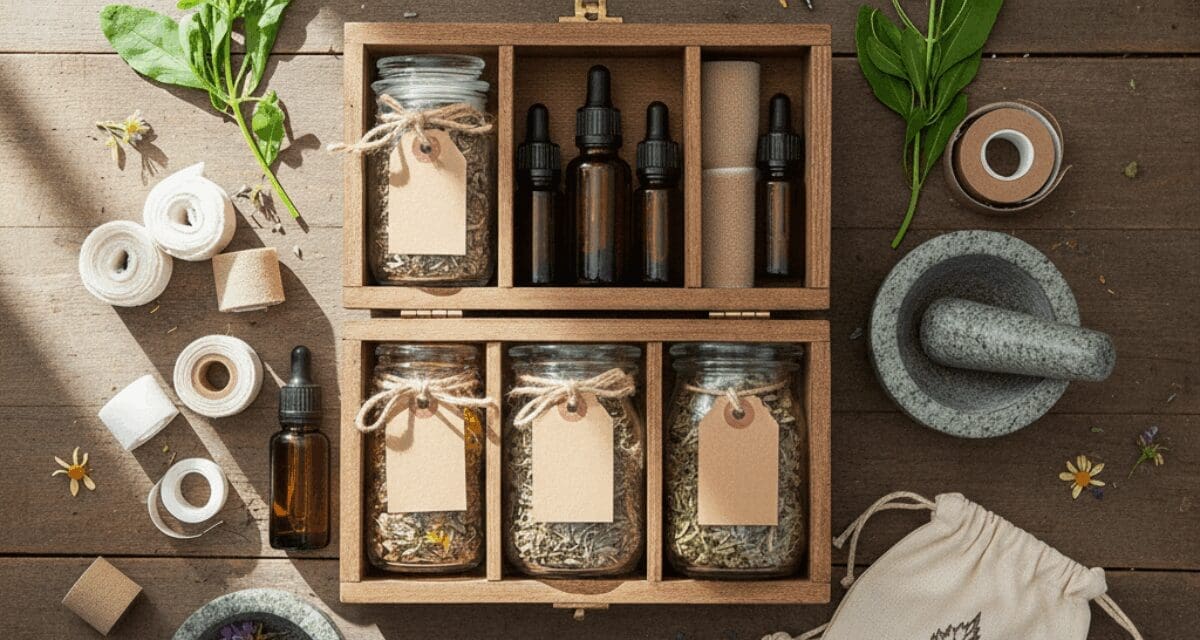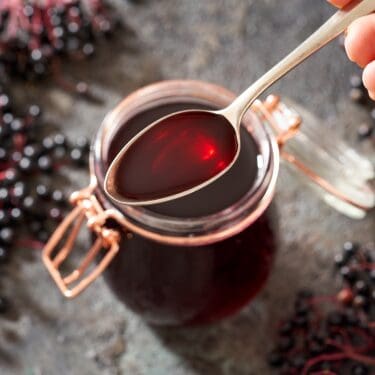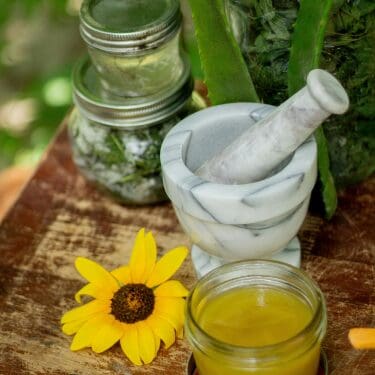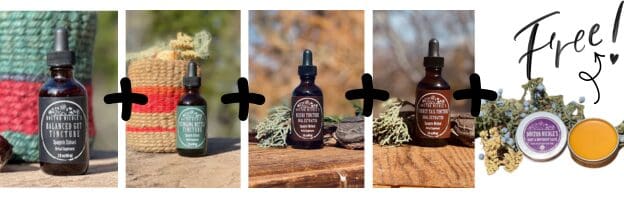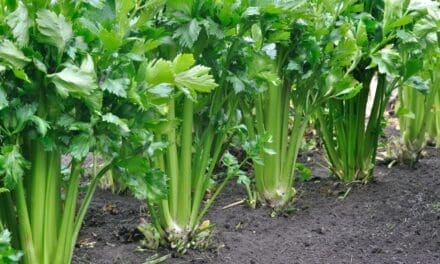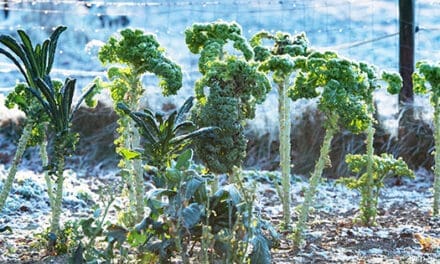Let’s face it: no one ever plans to cut their hand while doing household tasks, come down with a nasty cough after a weekend trip, or wake up with a bloated stomach and no idea what triggered it. But it happens. And when it does, it’s better to be ready with something that works and doesn’t come with a long list of side effects.
If you want to be well-prepared, you will need a reliable first aid kit. And instead of filling it with store-bought items, you can build your own using herbs you already grow in your backyard or even forage.
Don’t wait for something small to turn into a life-threatening situation. When things are starting to turn bad and help is nowhere in sight, having this on hand could actually save you.
Why Go Herbal?
When illness or injuries strike, most people turn to over-the-counter meds without thinking twice. But most of those solutions only mask the symptoms instead of going for the root of the problem. And they also usually come with a long list of side effects.
On the other hand, plants have been used for thousands of years to address common ailments. Many grow in your backyard or can be easily cultivated at home. With the right knowledge, you can manage minor injuries and problems without having to rely on pharmaceuticals or chemical-based products. Herbal options are also gentler on the body and don’t carry side effects.
What Should You Include In Your Kit?
When I built my own kit, it didn’t come together overnight. It actually grew from years of experience with everything from minor burns to stomach bugs, and the moments when I needed something fast and the drugstore was an hour away. But over time, I started building my little natural kit that’s now as normal to me as having band-aids in the drawer.
That said, a first aid kit only works if it has the right items. Focus on essentials that cover the most common issues you could face on your homestead: cuts, burns, insect bites, fevers, digestive issues. Make sure you include versatile herbs and basic supplies that help you respond quickly and effectively when problems arise.
Here’s what I keep in mine, and why:
1. For Wounds, Cuts, Scrapes and Bruises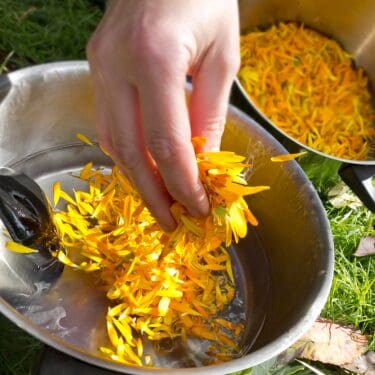
When you get a cut or scrape, your first move is to protect and calm the area. Calendula and plantain are essential for this.
Calendula works best as an oil infusion or salve. Apply a thin layer to the wound and cover with gauze. Plantain can be crushed fresh into a poultice or mixed into a salve for immediate application. If the scrape is deeper, rinse it with clean water first, then apply the poultice. Layer your cloth or gauze over the herbs and replace them as needed.
Prepare small jars of salve so you always have something ready, and keep fresh leaves or powdered plantain available for when you’re away from home. Include scissors for trimming leaves or gauze, tweezers to remove debris, and a small spoon to apply salves precisely.
2. Burns
Minor burns demand fast cooling and protection. Keep lavender and comfrey in your kit to calm discomfort and support skin recovery. Lavender can be applied as essential oil diluted in carrier oil, in a salve, or in a compress made with dried flowers. Comfrey works as an infused oil or salve to protect and soothe. Store your preparations in labeled jars, and always keep a clean cloth on hand for compresses. Reapply every few hours or after cleaning the burn to maintain comfort.
3. For Insect Bites and Stings
Itching, swelling, and irritation require herbs you can reach for instantly. Chamomile and peppermint reduce inflammation and cool the skin. Brew chamomile into a tea and apply it as a compress, or crush peppermint leaves into a paste for direct application. Keep premade compresses in tins for fast use, and have small jars of dried herbs or essential oils in your kit so you can respond anywhere on your property.
4. Fevers and Immune Support
At the first sign of fever, you need support that works internally. Echinacea and elderberry are pros at strengthening your body’s defenses. Echinacea can be taken as a tea or tincture, while elderberry syrup or dried berries provide additional immune support. Keep tinctures in dropper bottles for immediate use and store dried herbs airtight to preserve potency. Acting early can reduce symptom severity and keep you functioning through your daily tasks.
Label each item clearly so you can act without hesitation. Use these herbs at the first signs of fever or illness, and continue as needed until symptoms stabilize.
5. For Gut Health, Nausea, and Digestion Problems
Keep your stomach and gut functioning smoothly with ginger and fennel. Fresh ginger makes a tea that eases nausea, bloating, and general discomfort, while fennel seeds brewed as tea relieve gas and support gut function. Add a Slippery Elm infusion to coat and soothe the digestive tract when issues flare. Store dried fennel and slippery elm in jars, keep ginger infusions ready, and include a small spoon or tea infuser for fast preparation. Respond at the first sign of digestive upset to keep your gut calm and digestion on track.
When teas and infusions can’t keep up with stubborn bloating, nausea, or that heavy feeling after meals, it’s usually a sign your gut needs deeper repair. I recommend you try this double-extracted tincture as an addition to your daily routine. It contains Reishi and Turkey Tail to reduce gut inflammation and restore healthy bacteria, Plantain, Slippery Elm, and Marshmallow to protect the digestive lining, and Lion’s Mane to support the gut–brain connection, helping settle stress-related flare-ups. Just a few drops a day can help you finally stop dreading meals, ease chronic discomfort, and get your digestion working smoothly again. Here is where I always buy it from.
6. Headaches and Minor Pain
Mild aches require a mix of immediate relief and support for your body. Feverfew, willow bark, and Reishi are great options you should keep on hand. Feverfew works best when made into a tincture, willow bark as a warm tea, and Reishi as an infusion to reduce discomfort and support recovery. Keep clean cloths for compresses, jars for dried herbs, and dropper bottles for tinctures. Having these ready allows you to respond before headaches or tension interfere with your day.
>>> How to Make the Amish Migraine Killer <<<
7. Skin Irritations and Rashes
For rashes and irritation from plants or environmental factors, marshmallow root and plantain offer relief. Make a warm marshmallow root infusion and apply it as a compress to soothe the skin. Crush plantain leaves or use them in a salve to calm irritation directly. Keep cloths or gauze for larger areas, and rotate between fresh and stored preparations depending on what’s available. Applying herbs at the first sign of irritation prevents discomfort from spreading.
8. For Sleep
When your mind won’t slow down or your body can’t seem to relax, you’ll feel the effects through everything else, from your mood to your immunity. And once sleepless nights or anxious thoughts become a pattern, they can be hard to break without help.
If you’re feeling anxious and you can’t sleep, valerian and lemon balm can help you get your body and mind ready for nighttime. Brew valerian root as a tea or use it as a tincture for a calming effect, and combine it with lemon balm tea to reduce tension and quiet your mind.
Keep dried herbs in jars and pre-made tinctures or tea blends in your kit for fast access. Mini-tip: sip a warm tea 30–60 minutes before bed, and use a clean cloth compress of lemon balm on your forehead or neck for added relaxation.
9. For Bone and Joint Support
Over time, wear and tear on your bones and joints can lead to stiffness, aches, and reduced mobility, issues that gradually make daily tasks harder. Small aches left unchecked can turn into chronic problems that slow you down.
Certain herbs can support joint comfort and mobility. Comfrey, often called “knitbone,” contains allantoin, which stimulates cell growth and tissue regeneration. Apply it as a poultice or infused oil directly on sore or injured areas. Internal use is unsafe, so stick to topical applications. Stinging nettle helps reduce inflammation and flush out toxins, usually consumed as a tea or tincture. Turmeric has an active compound called curcumin and is a natural anti-inflammatory that can reduce joint discomfort when taken regularly.
If stiffness or joint pain keeps creeping back no matter how many teas or poultices you try, it’s time to support your joints from the inside out. This Joint & Movement Bundle combines powerful natural anti-inflammatories and tissue-repairing herbs to help ease pain, restore flexibility, and protect against further wear. It’s designed to target both the root inflammation and the long-term damage behind aching knees, stiff hands, and sore backs, so you can move freely again without relying on painkillers or constant rest.
If you grab the bundle, you get 4 powerful tinctures that help reduce inflammation, support joint health, and improve mobility, all at a special discounted price. And right now, you’ll also get the Joint & Movement Salve, a soothing topical blend that brings quick relief to sore knees, hips, and hands, completely for free.
Tools and Extras
In addition to the herbs, your kit should include: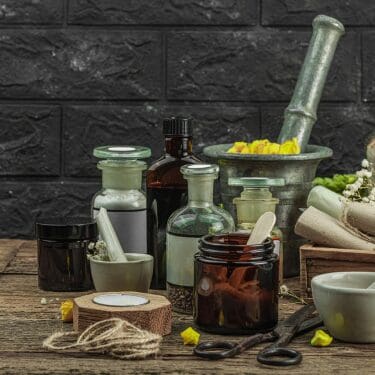
Small amber glass bottles (for tinctures)
Tin containers or jars (for salves)
Dropper bottles
Labels and a small field guide
Cheesecloth or muslin (for straining)
Bandages, gauze, tweezers, and scissors
Some More Tips For Always Staying Prepared
Your first-aid kit should be accessible, complete, and well-maintained. Check your supplies regularly, rotate fresh herbs, and make sure your tinctures, salves, and teas are stored in airtight containers to maintain potency. Keep your tools organized and within reach.
Think about where you spend the most time on your homestead and make sure your kit is always nearby, whether in the kitchen, barn, or workshop. You can also have a portable version for outdoor work, garden tasks, or trips to remote areas.
Final Thoughts
Don’t forget: preparation isn’t about panic, it’s about control. When such issues strike, you can respond immediately instead of waiting to get to a pharmacy or until professional help arrives. The herbs, tinctures, and salves you’ve chosen are there to give you fast, reliable support, so you can keep working, keep moving, and keep your homestead running smoothly, no matter what comes your way.
A little planning now prevents a lot of frustration later. So start putting together your kit today and let us know how the process goes in the comments below.
As always, happy homesteading!
In the meantime…
When Pharmacies Run Dry… This Is What You’ll Wish You Had
You can swap out your food. You can choose fluoride-free toothpaste. You can try to eat organic. But as long as you’re still dependent on over-the-counter pills, creams, and prescription drugs, you’re not safe.
The truth is, every shelf in every store is loaded with chemicals. Even the ones labeled “natural.” And if we ever reach a point where the system cracks — if supply chains freeze, shelves go empty, or drug ingredients get restricted — you’ll have nothing.
That’s when this book becomes your lifeline.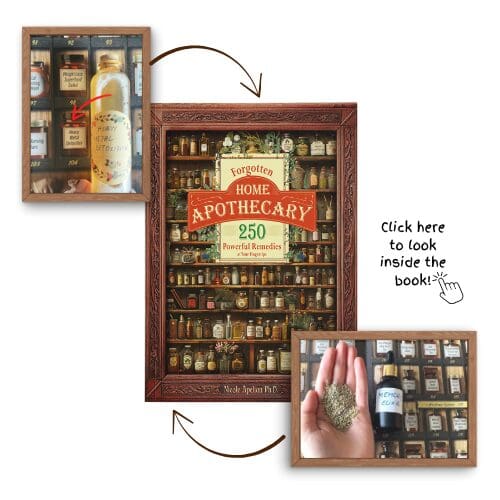
The Forgotten Home Apothecary is the ultimate guide to replacing chemical-laced, pharma-dependent products with powerful, time-tested remedies you can make at home.
You’ll learn exactly how to make your own tinctures, capsules, oils, teas, salves, elixirs, syrups, and poultices from plants you can find growing around you — or already in your kitchen.
These are not “Pinterest cures” or folk tales. These are battle-tested remedies used by herbalists, survivalists, and those who want real protection when nothing else is available.
Inside, you’ll discover powerful remedies like:
 Memory Elixir – made with rosemary to help restore clarity, focus, and short-term memory
Memory Elixir – made with rosemary to help restore clarity, focus, and short-term memory
 Painkiller in a Jar – crafted from wild lettuce, known as “nature’s opium” but legal, safe, and non-addictive
Painkiller in a Jar – crafted from wild lettuce, known as “nature’s opium” but legal, safe, and non-addictive
 Nature’s Amoxicillin – a plant-based antibacterial formula to help fight infections and boost immunity
Nature’s Amoxicillin – a plant-based antibacterial formula to help fight infections and boost immunity
 Medicinal Herbal Smoking Blend – designed to clear lungs and soothe inflammation with mullein and other wild herbs
Medicinal Herbal Smoking Blend – designed to clear lungs and soothe inflammation with mullein and other wild herbs
 Heavy Metal Detoxifier – flushes out mercury, aluminum, and lead from your bloodstream using safe, herbal chelators
Heavy Metal Detoxifier – flushes out mercury, aluminum, and lead from your bloodstream using safe, herbal chelators
 Herbal Parasite Flush – a powerful three-ingredient recipe to eliminate worms and cleanse your gut
Herbal Parasite Flush – a powerful three-ingredient recipe to eliminate worms and cleanse your gut
 The Backyard Aspirin – learn to use willow bark like early apothecaries did — it works like real aspirin, without the synthetic junk.
The Backyard Aspirin – learn to use willow bark like early apothecaries did — it works like real aspirin, without the synthetic junk.
And that’s just the beginning.
This book may be the only thing standing between you and full pharmaceutical dependence in a time of crisis.
 Click here to get The Forgotten Home Apothecary before it’s gone. Limited edition. Real remedies. No chemicals.
Click here to get The Forgotten Home Apothecary before it’s gone. Limited edition. Real remedies. No chemicals.
7 Herbs To Plant In Your Survival Garden
OTC Meds In Your Backyard: 10 Plant Alternatives (Video)

